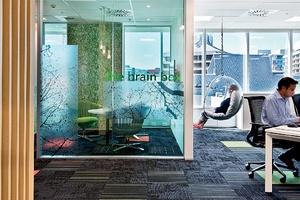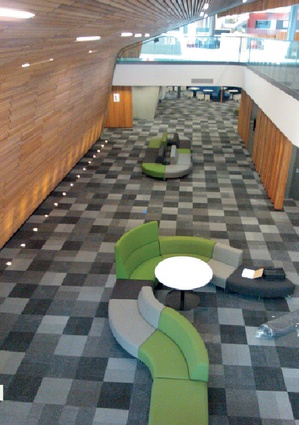Sound matters
Like water from a bucket with holes, the energy of sound finds every opportunity to annoy, no matter how small.
And, because sound cannot be seen, it is often neglected at the design and build stages, or when the focus is the physical structure. Much of today’s work thrives on interaction, collaboration and flexibility to achieve innovation. Key opportunities to innovate range from spontaneous conversations to planned meetings or individual research. Offices, schools, public spaces and healthcare facilities are ever evolving to suit these different work requirements and the acoustic comfort of occupants is paramount to modern work practises.
A Colliers International Office Tenant Survey in 2012 showed that one in three organisations are implementing or planning to implement Activity Based Working (ABW)¹, a concept which allows employees to find the best place for them to do their work by providing different task areas². Tasks can vary from collaborative work such as brainstorming to individual work like research and analysis. These tasks require two mutually exclusive work styles – interaction and focus. To allow for these different work styles, a variety of spaces are provided including private areas for confidential tasks, formal and informal meeting areas, and quiet areas. There is therefore a need to provide appropriate acoustic support to ensure acoustical comfort for employees.

Education facilities including primary, secondary and tertiary are also changing to more contemporary ways of learning. The Auckland University of Technology Sir Paul Reeves Building is a fantastic new example of the movement toward ABW in education facilities. The focus is again on task zoning. Furniture and technology are designed to cater for multiple types of learning³ and acoustical support in flooring, wall linings, ceiling panels, and the furniture itself ensures the spaces meet students’ task needs.
In primary and secondary schools, only 12 per cent of teaching time is spent using the didactic method.4 Teaching time is primarily made up of group discussions and other approaches. Despite the wide variety of methods, much of what children learn is through hearing and listening. Students require the best possible acoustic comfort in their classrooms because children are neurologically immature and lack the experience to predict from voiced context. Yet, 71 per cent of teachers surveyed reported that noise generated within the classroom is a problem and creates distractions which can impact negatively on children’s learning.5
It is not only offices and education facilities that can have acoustic comfort issues. The café effect commonly occurs in education facilities but also includes hospitality, retail and public spaces. The café effect refers to an escalation in noise levels in a listening environment when a speaker needs to raise their voice to be heard which leads to an escalation in voice levels.6 In a café or restaurant this is due to the noise of coffee machines or blenders but quickly moves on to raised voices by other patrons.
Within health and aged care, many situations can cause stress for patients and residents due to the sensitive nature of the occupants in these buildings. Many sounds are present in these environments including alarms, machines, rolling carts, conversations and footsteps along resilient floor corridors. Studies show that at peak times in a hospital, sound levels can often exceed 85 A-Weighted Decibels [dB(A)]. The recommended daytime level for patient areas is 35 dB(A).7 Aged care and healthcare environments can be the most complicated to incorporate acoustic comfort into due to the specialist nature of the interior linings needed in these facilities. Linings that need anti-microbial control, easy cleaning or impact resistance often do not incorporate NRC ratings in their material structure. Health & aged care facilities require specific strategic design which incorporates patient well-being, privacy and easy communication whilst meeting strict standards and regulations around infection control and cleaning.
All commercial interior spaces need to provide acoustical comfort for their occupiers. A recent acoustic satisfaction survey showed that over 60 per cent of office occupants thought poor acoustics interfered with their productivity, and a further 80 per cent of these people were distracted by other people talking on the phone. The same acoustic satisfaction survey also showed that when compared to other conditions including lighting and temperature, problems with acoustics was still the leading complaint.8
Integrating three key areas in acoustic design will deliver a workplace that will achieve key acoustical comfort needs for the users of that space. These three key areas are: human element, design and acoustic treatment.9
The human element of acoustics is difficult to design for because most interactions are spontaneous and to aid collaboration you do not want to control these interactions. Agreed workplace etiquette and enhanced employee mindfulness of colleagues are the key elements here to ensure adoption of the new spaces.

Design and acoustic treatment can be achieved through planning and zoning of spaces. Microsoft Wellington is a great example of workplace zoning where basic acoustic principles and aids have been adopted. Aids can include sound shells, low workstation partitions (talk softer as you can see others working), partition material that has a high Noise Reduction Co-efficient (NRC) rating and high NRC rated products on the ceilings, floors and walls.
The key to good acoustic design is to remember that once people arrive to use the space, sound matters. Creating a good looking but noisy environment is akin to building a leaky building. It looks good in the beginning but the attraction quickly wears off.
Footnotes:
1. Colliers International Australia 2013. (2013, August 5). 2012 Office Tennant Survey. Retrieved August 5, 2013, from Colliers International: www.colliers.com.au
2. Black, P., & Kuan, J. (2011). Activity Based Workplaces- Can it work for everyone? Melbourne, Victoria: Colliers International Australia.
3. The Fletcher Construction Company Limited. (2013, August 5). AUT Sir Paul Reeves Building. Retrieved August 5, 2013, from The Fletcher Construction Company: www.fletcherconstruction.co.nz
4 & 5. Oriole, W., Valentine, J., Halstead, M., McGunngile, K., Dodd, G., Hellier, A., et al. (2002). Classroom Acoustics: A New Zealand Perspective. Wellington: The Oticon Foundation in New Zealand.
6. Christie, L., & Bell-Booth, J. (2005). Acoustics in the Hospitality Industry: A Subjective and Objective Anaylsis. Wellington: Victoria University of Wellington
7. InformeDesign Research Desk. (2010). The current state of acoustics in healthcare environments. St Charles, Illinois: Ceilings & Interior Systems Construction Association.
8 & 9. U.S. General Services Administration. (2012). Sound Matters: How to achieve acoustic comfort in the contemporary office. Washington, DC: U.S. General Services Administration.












